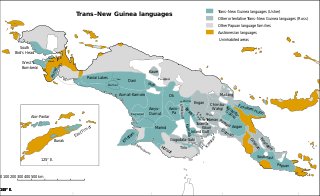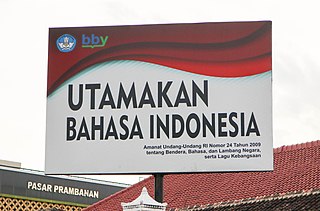Related Research Articles

Malay is an Austronesian language that is an official language of Brunei, Indonesia, Malaysia, and Singapore, and that is also spoken in East Timor and parts of Thailand. Altogether, it is spoken by 290 million people across Maritime Southeast Asia.

Trans–New Guinea (TNG) is an extensive family of Papuan languages spoken on the island of New Guinea and neighboring islands, a region corresponding to the country Papua New Guinea as well as parts of Indonesia.

The Sasak language is spoken by the Sasak ethnic group, which make up the majority of the population of Lombok, an island in the West Nusa Tenggara province of Indonesia. It is closely related to the Balinese and Sumbawa languages spoken on adjacent islands, and is part of the Austronesian language family. Sasak has no official status; the national language, Indonesian, is the official and literary language in areas where Sasak is spoken.
Nakanai is spoken by the Nakanai tribe in West New Britain, a province of Papua New Guinea. It is an Austronesian language, belonging to the Malayo-Polynesian subgroup. Otherwise known as Nakonai, it also has dialects in the form of Losa, Bileki, Vere, Ubae, and Maututu.
Vitu or Muduapa is an Oceanic language spoken by about 7,000 people on the islands northwest of the coast of West New Britain in Papua New Guinea.

More than 700 living languages are spoken in Indonesia. This figure indicates that Indonesia has about 10% of the world's languages, establishing its reputation as the second most linguistically diverse nation in the world after Papua New Guinea. Most languages belong to the Austronesian language family, while there are over 270 Papuan languages spoken in eastern Indonesia. The language most widely spoken as a native language is Javanese.
Tidore is a language of North Maluku, Indonesia, spoken by the Tidore people. The language is centered on the island of Tidore, but it is also spoken in some areas of the neighbouring Halmahera. A North Halmahera language, it is unlike most languages in Indonesia which belong to the Austronesian language family. Tidore and other North Halmahera languages are perhaps related to languages of the Bird's Head Peninsula, West Papua.
Iau or Turu is a Lakes Plain language of West Papua, Indonesia, spoken by about 2,100 people, native speakers of this language are the Turu people (Iau). Most speakers are monolingual, and their number is growing. Other peoples in the western Lakes Plain area speak basic Iau. Iau is heavily tonal, with 11 tones on nouns and 19 simple and compound tones on verbs.

The Mek languages are a well established family of Papuan languages spoken by the Mek peoples. They form a branch of the Trans–New Guinea languages (TNG) in the classifications of Stephen Wurm (1975) and of Malcolm Ross (2005).
Maybrat is a Papuan language spoken in the central parts of the Bird's Head Peninsula in the Indonesian province of Southwest Papua.
West Makian is a divergent North Halmahera language of Indonesia. It is spoken on the coast near Makian Island, and on the western half of that island.
Meyah (Meyakh) is a West Papuan language spoken in Miyah District, Tambrauw Regency of Southwest Papua, Indonesia. The Meyah language is agglutinative and head-marking and has no grammatical cases. It has subject-verb-object word order, which comes from nearby Austronesian languages.

The Hawu language is the language of the Savu people of Savu Island in Indonesia and of Raijua Island off the western tip of Savu. Hawu has been referred to by a variety of names such as Havu, Savu, Sabu, Sawu, and is known to outsiders as Savu or Sabu. Hawu belongs to the Malayo-Polynesian branch of the Austronesian language family, and is most closely related to Dhao and the languages of Sumba. Dhao was once considered a dialect of Hawu, but the two languages are not mutually intelligible.
Tambora is a (Papuan) and included in branch West Papuan spoken by the Tamboran people of central Sumbawa, in what is now Indonesia, that was made extinct by the 1815 eruption of Mount Tambora. It was the westernmost known Papuan language and was relatively unusual among such languages in being the language of a maritime trading state, though contemporary Papuan trading states were also found off Halmahera in Ternate and Tidore.

Kaure is a Papuan language of West Papua. It is spoken in the villages of Lereh, Harna, Wes, Masta, and Aurina.
Korupun (Korapun) is a Papuan language spoken in Yahukimo Regency, Highland Papua. Dialects are Korupun (Duram), Dagi, Sisibna (Gobugdua), Deibula, (Western) Sela. It is also known as Kimyal of Korupun; Kimyal is another name for Nalca. Indonesian Kemendikbud classified the former as Mek Nalca, while Korupun-Sela is classified as Kimyal.
Kilmeri, or bo apulyo is a Papuan language of Papua New Guinea near the border with Indonesian Papua. It is not being learned by children.
Eipo (Eipomek), or Lik, is a Mek language of the eastern highlands of Eipumek District, Pegunungan Bintang Regency, Highland Papua. It spoken by the Eipo people who live along the Eipo River. A large percentage of its vocabulary is shared with Una and Tanime, and they form one dialect area.
Muna is an Austronesian language spoken principally on the island of Muna as well as North-west Buton Island, off the southeast coast of Sulawesi in Indonesia. The language is well-documented, especially by linguist René van den Berg. In 2010, the language had around 270,000 speakers.
The Brazza River is a river in Papua province, Indonesia. The Brazza River has its source at over 3000 meters of elevation in the Jayawijaya or Maoke Mountains of central Papua in Yahukimo Regency and flows south to the lowland rainforests of Asmat Regency before meeting the Pulau River, which flows southeast to the Arafura Sea.
References
- ↑ Nalca at Ethnologue (18th ed., 2015) (subscription required)
- 1 2 "Bahasa Kimyal". petabahasa.kemdikbud.go.id. Retrieved 2 March 2023.
- 1 2 Rule, Rule & Cutting 1972.
- Rule, W. M.; Rule, J. E.; Cutting, R. (1972). Hmanggona Language of the Naltja Area. Irian Barat (A member of the Goliath Family of languages, previously called Kimjal by Mr S. Sadlier). Naltja; Statement of the Alphabet & Grammar.